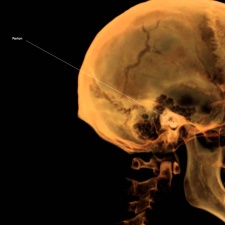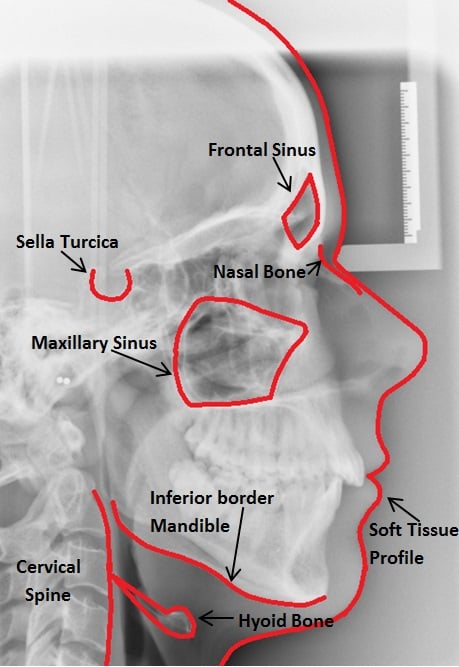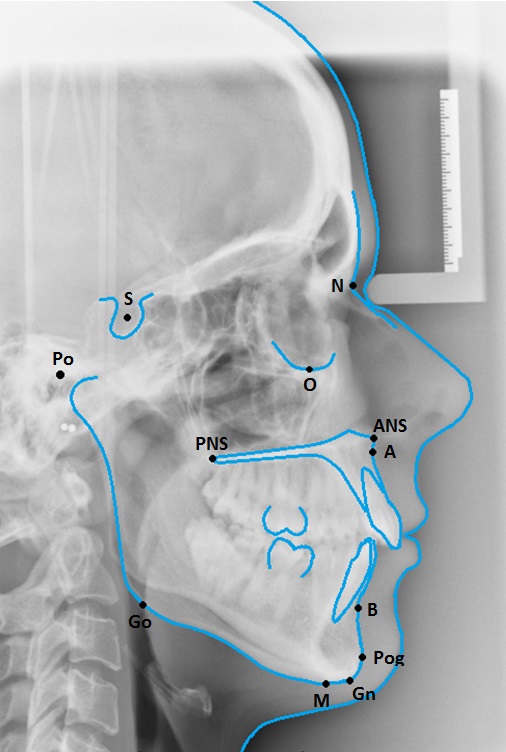Lydia Harris graduated from Bristol dental school in 2012 and is currently working as a Maxillofacial SHO in Bath. This article discusses the uses, indications and basic anatomical features present on a Lateral Cephalometric Radiograph, as well as discussing the basic definitions of points and planes used in cephalometric analysis.
 A lateral cephalometric radiograph (LCR) is a standardised, reproducible radiograph used primarily for orthodontic diagnosis and treatment planning. It is taken from a distance of 1.5m with the head at a right angle to the X-ray beam at a distance of 30cm, (although this has been found to vary slightly). A degree of magnification (around 8%) is expected and a scale may be incorporated to help calculate this. The cephalostat machine incorporates two posts which are placed in the external auditory meatus, the patient' sagittal plane should be parallel to the X-ray film, the teeth in centric occlusion and the Frankfort plane is aligned horizontally.
A lateral cephalometric radiograph (LCR) is a standardised, reproducible radiograph used primarily for orthodontic diagnosis and treatment planning. It is taken from a distance of 1.5m with the head at a right angle to the X-ray beam at a distance of 30cm, (although this has been found to vary slightly). A degree of magnification (around 8%) is expected and a scale may be incorporated to help calculate this. The cephalostat machine incorporates two posts which are placed in the external auditory meatus, the patient' sagittal plane should be parallel to the X-ray film, the teeth in centric occlusion and the Frankfort plane is aligned horizontally.
Uses
The LCR is used primarily in orthodontic diagnosis and treatment planning, particularly when considering orthognathic surgery. It is a useful record prior to treatment and can be used during treatment to assess progress. It is used to assess the aetiology of malocclusion; to determine whether the malocclusion is due to skeletal relationship, dental relationship or both. These radiographs can also be used for research purposes, although the radiographs must be clinically justified.
Once taken, the LCR should be traced; either by hand or digitally and analysed to help with treatment planning and diagnosis.
Anatomy
It is very important that prior to tracing the radiograph, it is examined for any pathology. Some of the basic anatomy seen on an LCR is detailed below.

Cephalometric Points
Below is a list of the most relevant cephalometric points. When starting a tracing, it is important to understand these definitions, and to be able to identify them on a radiograph.
A point (A) The point of the deepest concavity anteriorly on the maxillary alveolus
B point (B) The point of the deepest concavity anteriorly on the mandibular symphysis
Sella (S) The midpoint of the sella turcica (pituitary fossa)
Nasion (N) The most anterior point on the fronto-nasal suture
Orbitale (Or) The most anterior, inferior point on the infraorbital rim
Porion (Po) The upper midpoint point on the external auditory meatus
Anterior Nasal Spine (ANS) The tip of the anterior nasal spine
Posterior Nasal Spine (PNS) The tip of the posterior nasal spine
Gonion (Go) The most posterior, inferior point on the mandibular angle
Gnathion (Gn) The most anterior, inferior point on the mandibular symphysis
Menton (Me) The most inferior point on the mandibular symphysis
Pogonion (Pog) The most anterior point on the mandibular symphysis
Cephalometric Planes and Relationships
Planes and relationships are then established using the above points and it is with these that cephalometric analysis can be undertaken. Knowing what these planes and relationships are is key, as well as how they influence diagnosis and treatment planning.
SN line The plane demonstrated by a line through the nasion and sella
Frankfort Plane The plane demonstrated by a line through the orbitale and porion
Mandibular Plane (MnPl) The plane demonstrated by a line through the gonion and menton. The definition varies slightly, but the plane is used to show the plane of the lower border of the mandible
Maxillary Plane (MxPl) The plane demonstrated by a line through the anterior and posterior nasal spines
SNA This angle represents the relative anterioposterior position of the maxilla to the cranial base
SNB This angle represents the relative anterioposterior position of the mandible to the cranial base
ANB This angle represents the relative anterioposterior position of the maxilla to the mandible and can be used to determine skeletal class.
Inter-Incisal Angle The angle between the long axis of the maxillary incisors and the long axis of the mandibular incisors
Maxillary-mandibular plane angle (MMPA) The angle formed between the Maxillary Plane and Mandibular Plane
Maxillary Incisal Inclination (UInc to MxPl) The angle between the maxillary plane and the axis of the maxillary incisors (UInc)
Mandibular Incisal Inclination (LInc to MnPl) The angle between the mandibular plane and the axis of the mandibular incisors (LInc)
Average Values – Eastman cephalometric standard for Caucasians
Measurement
|
Mean Value + Standard Deviation
|
SNA
|
81˚±3˚
|
SNB
|
78˚±3˚
|
ANB
|
3˚±2˚
|
UInc to MxPl
|
109˚±6˚
|
LInc to MnPl
|
93˚±6˚
|
Inter-incisal angle
|
135˚±10˚
|
MMPA
|
27˚±4˚
|
Facial proportion
|
55%±2%
|

Interpreting
Once you have identified the anatomy on the radiograph, traced it and established all the above values and planes, the next step is to attempt to interpret them. This is done to help with diagnosis and treatment planning. In orthodontic assessments, there are 3 planes which are usually assessed; Anteroposterior, Vertical and Transverse relationships. Using the LCR, the Anterioposterior and Vertical relationship can be assessed. The transverse relationship can be assessed by posteroanterior views of the skull, although this is rarely done in practice.
- Anteroposterior Relationship
The anterior cranial base is generally constant after the age of seven, and as such, this is used as a stable point to compare the facial structure against. The sella turcica is used as this reference for the anterior cranial base. SNA and SNB determines the antereroposterior relationship of the mandible or maxilla relative to the cranial base. If this is increased/decreased compared to the mean values, it means the jaws are positioned more anteriorly or posteriorly.
The skeletal pattern can be assessed by looking at angle ANB, which compares the difference between SNA and SNB, and therefore determines the relationship of the maxilla relative to the mandible. If the angle ANB is between 2-4Ëš, the anteroposterior skeletal pattern is largely considered to be Class I. If ANB is less than 2Ëš, it is Class III and if it is greater than 4Ëš then this is considered to be Class II. The position of the nasion affects these measurements significantly, and corrections can be utilised to adjust should SNA be significantly different to the average value.
The incisal position is determined using the angles UInc to MxPl, LInc to MnPl and the Inter-incisal angle. These show whether the incisors are average, retroclined or proclined. The inter-incisal angle shows how deep the overbite is; if the angle is increased, the patient has a deeper overbite.
- Vertical Relationship
This is generally assessed by looking at the MMPA (see average values above) as this will indicate the facial height proportions. An increased MMPA indicates a backward pattern of mandibular growth and a decreased overbite.
Once analysis has been completed, this should enable you to create a problems list, understand the aetiology of the malocclusion, and therefore help to treatment plan. A lateral cephalometric radiograph is integral to orthodontic treatment planning in many cases and it is important for all dentists to have an understanding of how to interpret them and their uses.
References
Mitchell L, Littlewood SJ, Nelson-Moon ZL, Dyer F. Introduction to Orthodontics (4th Ed). Oxford University Press; 2013
Whaites E, Drage N. Essentials of Dental Radiography and Radiology. Churchill Livingstone; 2013
Heasman P. Master Dentistry Volume 2. Churchhill Livingstone; 2009
British Standards Institute. Glossary of Dental Terms (BS 4492), BSI, London; 1983
Lydia Harris